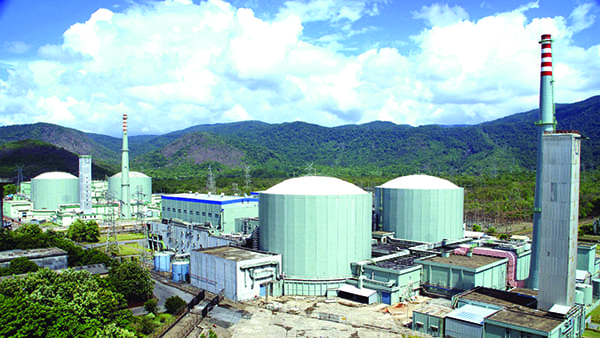Indian-Designed Nuclear Reactor Breaks Record for Continuous Operation
India’s 220-MW Kaiga 1 nuclear power plant, an indigenously designed pressurized heavy water reactor (PHWR), on Dec. 31 became a world record holder for running 962 unbroken days. The previous record for continuous operation was held by Heysham-2 Unit 8 in the UK, which ran 940 days before it was taken offline on Dec. 10.
The state-owned Nuclear Power Corp. of India Ltd. (NPCIL) said the 1999-completed unit (Figure 1) at the four-unit plant in Uttara Kannada district of Karnataka state continuously operated from May 13, 2016, until Dec. 31, 2018, when it was taken offline for inspection and maintenance. During that period, the unit generated about 5 billion units of electricity at a plant load factor of about 99.3%.
 |
|
1. The 220-MW Kaiga 1 in Uttara Kannada district of India’s Karnataka state went offline on Dec. 31, 2018, after completing 962 days of continuous operation—a world record. Courtesy: India Department of Atomic Energy |
Kaiga 2, 3, and 4 (which were completed between 2000 and 2012) are still running, and as of Jan. 1, Kaiga 2 had operated continuously for 661 days. NPCIL noted that along with Kaiga, several Indian nuclear reactors have achieved continuous operation of more than 365 days 28 times. Two other reactors, Rajasthan 3 and Rajasthan 5, have reportedly achieved continuous operating runs of 777 days and 765 days, respectively.
The record unbroken run “demonstrates the pre-eminence of NPCIL in the design, construction, and operation of PHWRs with unprecedented levels of efficiency and safety,” NPCIL said in a statement. Specifically, the entity credited “a synergistic partnership forged between public sector enterprise and the industry partners in the private sector,” adding these have been “instrumental in gaining wide ranging experience and expertise and developing world class technology in this domain, which is now being fruitfully leveraged towards the expansion of the nuclear power programme of the country.” New Delhi–based state-owned engineering and manufacturing company Bharat Heavy Electricals Ltd. (BHEL), which equipped Kaiga 1 with its steam turbine generator set, said in a separate statement that the achievement showed India’s indigenous nuclear program had attained maturity.
India currently operates 18 PHWRs, each rated at either 220 MW or 540 MW, for a total installed PHWR capacity of 4.5 GW. NPCIL, meanwhile, is building four 700-MW PHWRs, two at Kakrapar Atomic Power Station in Gujarat and two at Rajasthan Atomic Power Station. BHEL steam turbine generator sets are installed at 12 of India’s 18 operating PHWRs. BHEL noted it has been “a partner for over four decades in the development of the indigenous nuclear power program since its inception.”
India’s nuclear power sector was conceived in 1948, shortly after independence, when it established its Atomic Energy Commission. In the beginning, the nuclear energy program was modest, owing largely to its lack of resources. The country has sparse uranium resources, but it holds 25% of the world’s total reserves of thorium (which is not fissile). In 1974, the country was excluded from the Nuclear Non-Proliferation Treaty for acquiring nuclear weapons capability, and during the next three decades in isolation, when it was viewed as a nuclear pariah, the country developed a three-stage nuclear program based on a closed-fuel cycle, where spent fuel of one stage is reprocessed to produce fuel for the next stage.
The first step of the three-stage program involves building indigenously engineered PHWRs fueled by natural uranium (U). “Natural uranium contains only 0.7% of U-235, which undergoes fission to release energy (200 Mev/atom). The remaining 99.3% comprises U-238, which is not fissile, however, it is converted in the nuclear reactor to fissile element Plutonium-239 [Pu-239]. In the fission process, among other fission products, a small quantity of Pu-239 is formed by transmutation of U-238,” NPCIL explained. The country’s first 220-MW PHWR at Rajasthan 1, completed in 1973, was based on CANDU (Canada Deuterium Uranium) technology, but India relied on domestic designs for the others after Canadian assistance was withdrawn in 1974, even as the second Rajasthan unit was under construction. In 1981, it completed Rajasthan 2, and went on to complete Madras 1 and 2 between 1984 and 1986 using a standardized 220-MW PHWR design. Kaiga 1 and 2, and Rajasthan 3 and 4, which came online around 2000, incorporated improvements to the design.
The nuclear program’s second stage comprises fast breeder reactors (FBRs), which are fueled by mixed oxide of U-238 and Pu-239, recovered by reprocessing of the spent fuel from the first stage. Once the program has established enough inventory of Pu-239, the fast reactors will use Thorium-232 to breed U-233, NPCIL said. The country currently has plans to build two prototype FBRs at Kalpakkam in Tamil Nadu, a site that already hosts a 500-MW fast breeder test reactor. In September 2018, the Department of Atomic Energy announced that the test reactor—which was originally expected to be commissioned in 2012 and has suffered several delays—is expected to achieve criticality in 2019. In the third stage, using wholly indigenous technology, the country will use advanced heavy-water reactors fueled with U-233 obtained from the irradiation of thorium in PHWRs and fast reactors.
—Sonal Patel is a POWER associate editor.